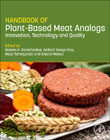
Handbook of Plant-Based Meat Analogs: Innovation, Technology and Quality
Ravishankar, Gokare A.
Ranga Rao, Ambati
Tahergorabi, Reza
Mohan, Anand
Handbook of Plant-Based Meat Analogs: Innovation, Technology and Quality presents the growing opportunities and challenges of meat substitutes from plant-based resources. Addressing core topics from source ingredients to consumer acceptance, it provides a comprehensive starting point for those seeking to explore sustainable meat alternative products. To date, the full potential of plant-based meat products has been underexplored, underutilized, and underrepresented. This book provides the most up-to-date information on plant-based meat analogs, sources of ingredients, industrial processes, large-scale production, and health benefits, including safety and regulatory aspects and environmental implications. Organizes chapters by sections on types, processing, health benefits, sensory evaluation, and regulatory/safety issues of meat analogsIncludes methods and protocols for producing, storing, and evaluating meat analogsCovers meat analogs from plants, grains, nuts, microbes, and moreProvides case studies to illustrate concepts and practices INDICE: Section-I Meat analogs from different sources: Plant, microalgae, seaweeds, microorganisms and other sources Chapter 1 The potential of Mexican Plant Based Ingredients in Meat Analogues Formulation: Opportunities and Gaps in Reformulated Mexican Dishes Chapter 2 Processing of plant proteins in the development of plant-based meat analogs Chapter 3 Soybean and pea proteins as functional and nutritional ingredients of plant-based meat analogs. Chapter 4 Pea as a key ingredient in plant based meat analogues: a comprehensive treatise Chapter 5 Mycoproteins for use in meat analogs: A scientific description and potential utilities Chapter 6 Fungi based meat analogues Chapter 7 Suitability of microalgae based meat analogues: an overview Chapter 8 Seaweed protein-based meat analogs: Current trends and future prospects Chapter 9 Plant based fermented foods and microbial ingredients in meat analogs Chapter 10 Utilization of fruits and vegetable processing wastes for meat analog- products Chapter 11 Health implications of plant-based meat analogs; Section-II Emerging technologies for the production of meat analogs for commercialization Chapter 12 Application of sustainable processes for treatment of ingredients for meat analogs Chapter 13 Meat analogs: Some insights into the production techniques and their applications Chapter 14 3D printing of plant-based meat analogs for designer products as sustainable future food Section-III Physico-chemical composition and sensory evaluation Chapter 15 Flavor challenges in designing plant-based meat analogs: An overview Chapter 16 The textural and sensorial properties of plant-based meat Chapter 17 Functional properties of meat analog products consisting of plant-derived proteins Section-IV: Regulatory, safety, quality and consumer acceptance Chapter 18 Packaging and shelf life studies of plant-based meat analogs Chapter 19 Culinary Science and Skills of Plant-based meat alternatives: Chapter 20 Flexitarian foods: Do plant-based meat analogues facilitate flexitarian diets? Chapter 21 Plant ingredients in meat analogs addressing religious requirements Chapter 22 Facilitating flexitarian approaches with plant-based meat analogs aligning with the UN Sustainable Development Goals (SDGs) Chapter 23 Projected future trends of plant-based meat analogs
- ISBN: 978-0-443-21846-0
- Editorial: Academic Press
- Encuadernacion: Rústica
- Páginas: 600
- Fecha Publicación: 20/05/2024
- Nº Volúmenes: 1
- Idioma: Inglés
